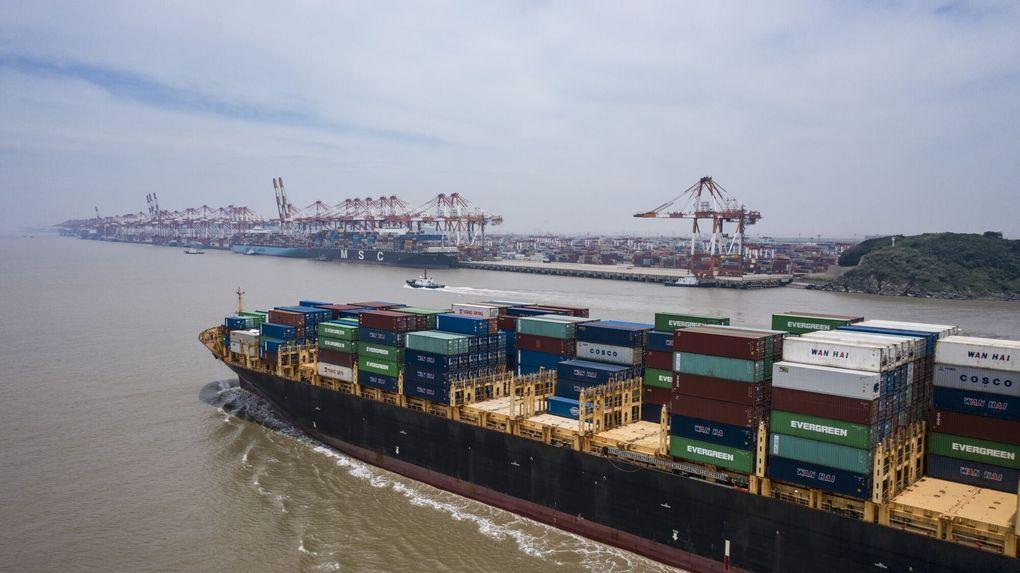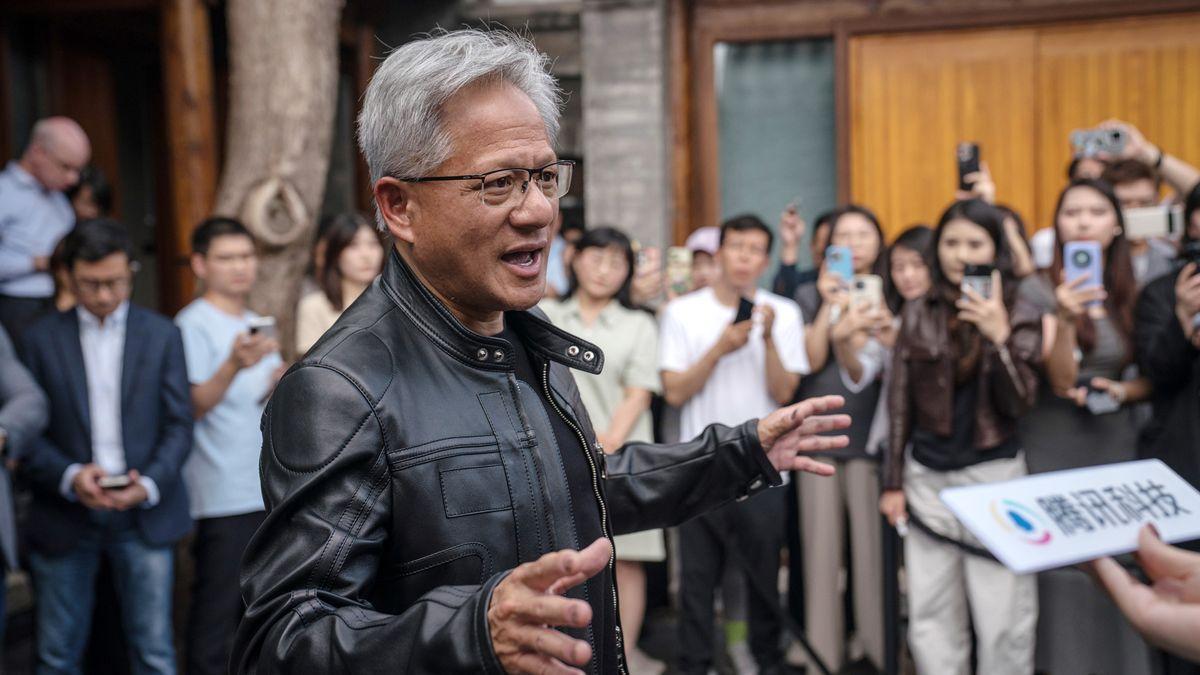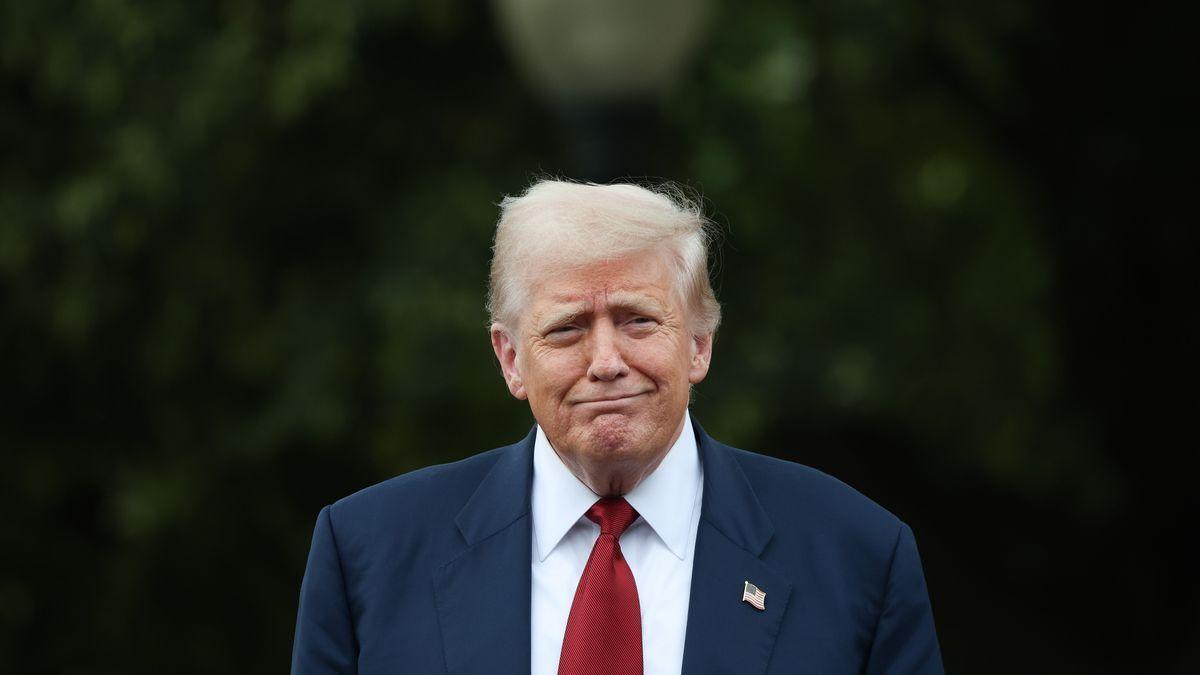Trump Extends China Tariff Deadline, Eases AI Chip Export Restrictions Amid Ongoing Trade Talks
3 Sources
3 Sources
[1]
Trump extends China tariff deadline by another 90 days
Treasury Secretary Scott Bessent and Chinese Vice Premier He Lifeng during meetings in Stockholm, Sweden, July 28, 2025. U.S. Treasury / AFP - Getty Images The Trump administration agreed to once again delay the deadline when tariffs on Chinese imports would rise as discussions between the two sides continue. The new deadline would be November 10. "All other elements of the Agreement will remain the same," Trump said on Truth Social. For companies and consumers, another pause means continued uncertainty as President Donald Trump's sweeping tariff regime enters its fifth month. Last week, import taxes went into effect for dozens of countries. Prices have ticked up in the United States while existing tariffs on imports from China and others work their way into the economy, with companies eating much of the higher costs and consumers absorbing some. Trump has downplayed inflation concerns and lauded the tens of billions of dollars in federal revenue from the levies. It's second time that the Trump administration has delayed imposing even higher tariffs on China, which is one of America's largest trading partners. In 2024, the United States imported more than $438 billion worth of goods, including everything from clothing to electronics to toys, from China. While there's no deal in hand, there's been movement on a few fronts. Just days ago, President Donald Trump authorized Nvidia and AMD to begin selling some of their artificial intelligence semiconductors into China again. China has also reportedly eased some restrictions on exports of rare earth metals. Those were key issues for both sides. Trump's back-and-forth with China over tariffs started just days after he re-entered office. In early February, he imposed a 10% tariff on all imports from China which quickly retaliated with higher tariffs of its own. Then, on April 2, Trump said he would slap a 34% tariff on China. Then, a week later, after China hiked its tariffs on U.S. goods to 84%, Trump said on Truth Social: "Based on the lack of respect that China has shown to the World's Markets, I am hereby raising the Tariff charged to China by the United States of America to 125%, effective immediately." That brought all of China's tariffs to a total of 145%. In early May, seeking to defuse the tension, Treasury Secretary Scott Bessent and U.S. Trade Representative Jamieson Greer met with their Chinese counterparts in Geneva. Following those talks, China and the U.S. both lowered tariffs on each other by 115% for 90 days. The resulting U.S. tariff on Chinese goods remained at 30%. Just weeks later, Trump said on Truth Social that "China, perhaps not surprisingly to some, HAS TOTALLY VIOLATED ITS AGREEMENT WITH US." U.S. officials later said that China was "slow rolling" the delivery of rare earths. Bessent and Greer met again with their counterparts, namely China's Vice Premier He Lifeng, in London in mid-June. Commerce Secretary Howard Lutnick also joined those talks, which yielded positive language. "The two largest economies in the world have reached a handshake for a framework," Lutnick said at the conclusion of the London talks. Since that meeting, the details of that framework agreement has not been released or published by either government. But those discussions did eventually lead to China resuming shipments of some rare earths used for manufacturing vehicles, smartphones, batteries and a number of other everyday items. The U.S. also allowed A.I. chipmakers Nvidia and AMD to restart sales of some of their chips into China, which they were temporarily banned from doing. Nvidia took a $5.5 billion hit from that ban while AMD predicted an $800 million impact. But a fully-fledged trade deal with China remains elusive despite at least seven days of face-to-face talks this year between high ranking officials on both sides.
[2]
Trump extends China truce for 90 days, averting tariff hike
President Donald Trump extended a pause of sky-high tariffs on Chinese goods for another 90 days into early November, stabilizing trade ties between the world's two largest economies. Trump signed an order extending the truce, according to a person familiar with the matter. The pact, which saw the U.S. and China agree to reduce tit-for-tat tariff hikes and ease export restrictions on rare earth magnets and certain technologies, was due to expire Tuesday. The text of the order wasn't immediately available and it was unclear if it included any other changes to U.S. trade policy or to the terms of the arrangement. Negotiators from both sides reached a preliminary agreement to keep the deal last month in Sweden, and the president's advisers had expressed optimism he would approve it -- but Trump has made last-minute demands and changes in prior trade matters. Had the truce not been extended, U.S. tariffs on Chinese goods would have jumped to at least 54% starting after midnight in New York. The White House declined multiple requests for comment. Trump, speaking to reporters earlier Monday, demurred when asked if he would extend the deal. CNBC reported earlier on the signing. "We'll see what happens," Trump said when asked if he would extend the deadline. "We've been dealing very nicely with China." The extension will ease worries of a renewed tariff war that threatens to choke off trade between the U.S. and China. An escalation between Washington and Beijing earlier this year shook global financial markets. It will also gives the countries more time to discuss other unresolved issues such as duties tied to fentanyl trafficking that Trump has levied on Beijing, American concerns about Chinese purchases of sanctioned Russian and Iranian oil and disagreements around U.S. business operations in China. The signing may clear the path for Trump to visit China to meet with President Xi Jinping in late October, around the time of an international meeting in South Korea that the U.S. leader is likely to attend. Trump earlier this year ratcheted up tariffs on Chinese goods, and Beijing responded in kind. U.S. tariffs on Chinese imports ultimately reached 145%, and China curbed access to magnets critical to U.S. manufacturers. The two sides reached a 90-day truce in May, under which the U.S. lowered its China duties to 30% while Beijing reduced levies on U.S. goods to 10% and agreed to resume rare earth exports. Trump's willingness to parlay with China has prompted concerns from national security hawks that he's unwilling to crack down on the the U.S.'s biggest geopolitical rival. Nvidia Corp. and Advanced Micro Devices Inc. reached deals with the Trump administration to secure export licenses by agreeing to pay 15% of their revenues from certain Chinese artificial intelligence chip sales to the US government. Trump earlier Monday also signaled openness to separately allowing Nvidia to sell a scaled-back version of its most advanced AI chip to China, saying that "it's possible I'd make a deal." With the deadline nearing, Trump on Sunday had called on Beijing to quadruple purchases of American soybeans, something he said would held reduce the US trade deficit with China. Trump's decision to extend the truce follows two days of discussions in Stockholm in July led by US Treasury Secretary Scott Bessent and Chinese Vice Premier He Lifeng -- the third round of talks between the Washington and Beijing in less than three months. While Chinese officials and the Communist Party's official newspaper had signaled satisfaction with the Stockholm talks, and US Cabinet secretaries predicted an extension, the pact remained fragile. Bessent had said that any decision to extend the deal would be up to Trump. Rare earths At issue in the ongoing dialogue is how the two countries will seek to maintain a stable trading relationship while applying barriers like tariffs and export controls to limit each other's progress in critical sectors including battery technology, defense and semiconductors. Both sides have been taking steps to turn down the temperature and reduce flashpoints recently, with Chinese exports of rare earth magnets starting to recover in June and the US saying it would approve shipments of a semiconductor used for artificial intelligence that it had blocked. U.S. Trade Representative Jamieson Greer, who participated in the Stockholm negotiations, has sounded an optimistic note on discussions with China over rare earth flows, saying that the US had secured commitments about their supply. "We're focused on making sure that magnets from China to the United States and the adjacent supply chain can flow as freely as it did before the control," Greer told CBS's Face the Nation in a recent interview. "And I would say we're about halfway there." Flows of rare earth magnets from China to the US rose to 353 tons in June, up from just 46 tons in May, according to the latest customs data. Total shipments were still substantially lower than before Beijing launched export controls in early April. Sales of advanced AI chips remain an issue, despite Trump's decision to relax export controls. Chinese authorities in late July summoned Nvidia to discuss alleged security vulnerabilities related to its H20 chips. Tariff push China-US negotiations have been on a separate track from other talks the Trump administration has held with trading partners as it moves to implement sweeping so-called reciprocal tariffs and industry-specific levies on other economies. Trump's 30% duties are comprised of a 20% levy tied to fentanyl and a 10% baseline charge. That's on top of existing tariffs on certain Chinese products from his first term. Bloomberg's Paul Abelsky, Charlie Duxbury and Olivia Tam contributed.
[3]
President Trump delays new China tariffs for 90 days amid trade talks and Nvidia chip export deal
US President Donald Trump has postponed new tariffs on China for 90 days, pushing the deadline to November 9. This pause maintains current tariff rates from May, amidst ongoing trade discussions. Recent focus on Russia and Ukraine, including tariffs on Indian imports, adds complexity. The pause may facilitate a Trump-Xi meeting, with potential talks on semiconductors and rare earth minerals. U.S. President Donald Trump signed an executive order on Monday to pause new tariffs on China for another 90 days. This pause delays the extra tariffs that were supposed to start on Tuesday, as reported by CNBC, Wall Street Journal, Washington Post. The new deadline for these tariffs is now pushed back to November 9. The White House did not immediately comment when asked about this decision. This means the current tariff rates from May -- 30% on Chinese imports and 10% on American goods -- will stay the same for now. These tariffs will not go back up to the very high previous levels, which were more than 100% in some cases. Some tariffs on specific products like steel and medical supplies will still keep the overall trade taxes between the US and China high, as per the report by Yahoo Finance. ALSO READ: Nvidia strikes $3 billion revenue-sharing deal with Trump administration to resume AI chip sales in China Recently, Trump has also focused on Russia and Ukraine issues and added a 25% tariff on Indian imports because India is buying Russian oil. This tariff pause might increase chances for a meeting between Trump and Chinese President Xi Jinping later this year. Both the US and China have suggested they might meet at the Asia-Pacific Economic Cooperation summit in South Korea at the end of October. The tariff pause comes after three meetings between the US and Chinese trade teams in recent months: in Geneva (May), London (June), and Stockholm (July), as stated by Yahoo Finance. These meetings showed some progress but tensions still remain between the two countries. China's Vice Premier for economic policy, He Lifeng, attended all three meetings. After the last meeting in Sweden, Chinese trade negotiator Li Chenggang said the two sides had "candid exchanges over their economic concerns." ALSO READ: US inflation rises to 2.8% in July 2025 as Trump tariffs push prices higher, core CPI hits six-month high Important topics in talks include semiconductors, especially plans to restart exports of Nvidia AI chips to China. Chinese exports of rare earth minerals are also part of the discussions. Many other trade issues between the US and China still need to be resolved, according to the report by Yahoo Finance. Over the weekend, the US government made a deal with Nvidia and AMD to allow these companies to sell some chips in China. In return, Nvidia and AMD agreed to give 15% of the sales from China back to the US government. Q1. Why did President Trump pause tariffs on China? He paused tariffs to give more time for trade talks and avoid raising taxes on imports. Q2. When will the new tariffs on China start after the pause? The new tariffs are delayed until November 9, 2025.
Share
Share
Copy Link
President Trump delays new tariffs on China for 90 days, maintaining current rates amid ongoing trade discussions. The decision comes alongside easing of restrictions on AI chip exports to China and progress in rare earth mineral trade.
Trump Extends China Tariff Deadline
President Donald Trump has signed an executive order extending the deadline for imposing higher tariffs on Chinese imports by 90 days, pushing the new date to November 10, 2025
1
. This decision maintains the current tariff rates established in May, with the U.S. levying a 30% duty on Chinese goods and China imposing a 10% tariff on American products .
Source: Seattle Times
Ongoing Trade Negotiations
The extension comes after several rounds of high-level talks between U.S. and Chinese officials. Treasury Secretary Scott Bessent and U.S. Trade Representative Jamieson Greer have met with their Chinese counterparts, including Vice Premier He Lifeng, in various locations such as Geneva, London, and Stockholm
1
. These discussions have yielded some progress, with both sides expressing cautious optimism about reaching a comprehensive trade agreement.AI Chip Exports and Rare Earth Minerals
A significant development in the ongoing negotiations has been the easing of restrictions on artificial intelligence (AI) chip exports to China. The Trump administration has authorized Nvidia and AMD to resume selling some of their AI semiconductors to Chinese customers
1
. In return, these companies have agreed to pay 15% of their revenues from certain Chinese AI chip sales to the U.S. government3
.
Source: ET
Simultaneously, China has shown signs of easing its restrictions on rare earth mineral exports, a crucial component in various high-tech industries. U.S. Trade Representative Greer reported that the country had secured commitments regarding the supply of these materials .
Related Stories
Economic Impact and Future Prospects
The extension of the tariff deadline provides temporary relief for businesses and consumers, who have been grappling with increased costs and market uncertainty. However, it also prolongs the period of economic ambiguity as President Trump's tariff regime enters its fifth month
1
.The decision to extend the deadline may pave the way for a potential meeting between President Trump and Chinese President Xi Jinping. There are indications that such a meeting could take place in late October, possibly around the time of an international gathering in South Korea .
Broader Trade Context
It's worth noting that these U.S.-China trade negotiations are occurring alongside other trade-related actions by the Trump administration. Recently, the U.S. imposed a 25% tariff on Indian imports, citing India's purchase of Russian oil
3
. This move underscores the complex global trade landscape that the administration is navigating.As negotiations continue, both sides face the challenge of balancing their economic interests with national security concerns, particularly in critical sectors such as semiconductor technology and rare earth minerals. The outcome of these talks will likely have far-reaching implications for global trade and technological development in the coming years.
References
Summarized by
Navi
[2]
Related Stories
Trump Administration Pauses Tech Export Controls to China, Sparking AI Security Concerns
28 Jul 2025•Policy and Regulation

US-China Trade Tensions: AI and Chip Exports at the Center of Potential TikTok-for-Tariffs Deal
06 Feb 2025•Business and Economy

Trump's Proposed 300% Chip Tariff Shakes Tech Industry, Raises Concerns for AI Sector
16 Aug 2025•Business and Economy

Recent Highlights
1
Google launches Gemini 3 Flash as default AI model, delivering speed with Pro-grade reasoning
Technology

2
OpenAI launches GPT Image 1.5 as AI image generator war with Google intensifies
Technology

3
OpenAI launches ChatGPT app store, opening doors for third-party developers to build AI-powered apps
Technology





